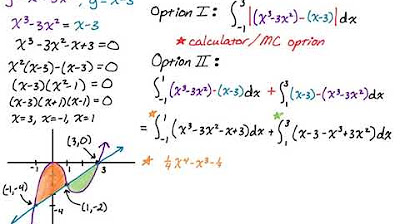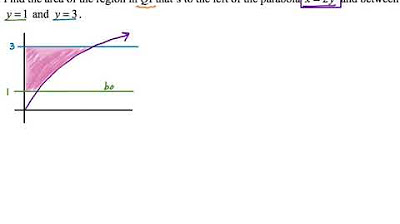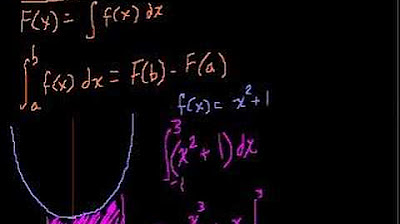Definite Integrals (part 5)
TLDRThe video script discusses the process of calculating the area between two curves, specifically the square root of x and x squared, from 0 to 1. The presenter uses calculus and the concept of antiderivatives to find the area, which simplifies to a neat result of 1/3. An additional problem involving the area under an absolute value function is introduced, highlighting the use of symmetry and algebraic manipulation to solve complex problems.
Takeaways
- 📈 The problem involves calculating the area between two curves, specifically from x=0 to x=1.
- 🌟 The first approach is to find the area under the square root of x and then subtract the area under x squared.
- 📚 The indefinite integral is used to solve the problem, relying on the fundamental theorem of calculus.
- 🎨 The script uses different colors to illustrate the process, with magenta highlighting the main area of interest.
- 🔄 The antiderivative of the square root of x is found by raising the power to 3/2 and dividing by the new exponent.
- ➖ The final area is determined by evaluating the antiderivative at the bounds and subtracting the results (1/3 in this case).
- 🔢 The second problem involves finding the area under x to the fifth power up to the height of 32.
- 🔄 A horizontal line function at y=32 is used as the upper boundary to calculate the area.
- 🔢 The area is calculated by setting up an integral from -2 to 2, utilizing symmetry to simplify the process.
- 🤔 The final calculation involves an algebraic expression that needs to be evaluated and then multiplied by 2 to account for the symmetry.
- ⏳ The script ends with an unfinished calculation, leaving the audience to complete the problem on their own.
Q & A
What is the area being calculated in the script?
-The area between the curves y = sqrt(x) and y = x^2 from x = 0 to x = 1.
How does the script suggest finding the area under the square root of x from 0 to 1?
-By finding the indefinite integral of the function sqrt(x) from 0 to 1.
What is the significance of subtracting the purple area in the script's explanation?
-Subtracting the purple area, which represents the area under x^2, helps in determining the area between the two curves.
What is the antiderivative of sqrt(x)?
-The antiderivative of sqrt(x) is (2/3)x^(3/2).
What is the antiderivative of x^2?
-The antiderivative of x^2 is (1/3)x^3.
What is the final result of the area between the square root of x and x squared from 0 to 1?
-The final result is 1/3.
How does the script introduce the second problem involving x to the fifth power?
-The script introduces the second problem by asking for the area inside the curve y = x^5 where the height is 32.
What horizontal function is used to find the area inside the curve y = x^5?
-A constant function g(x) = 32 is used to find the area inside the curve.
What is the mistake corrected in the script when discussing the second problem?
-The mistake corrected is the initial choice of function; instead of y = x^5, it should be y = |x^5| to have a cup-shaped graph.
What is the symmetry observed in the second problem?
-The symmetry observed is that the area inside the curve y = |x^5| where the height is 32 is symmetric about the y-axis, allowing the calculation to be done for one interval and then multiplied by 2.
What is the final expression for the area inside the curve y = |x^5| where the height is 32?
-The final expression is (128 - 128/6) * 2, which simplifies to (128 * 5/6).
Outlines
📈 Calculating the Area Between Two Curves
The paragraph begins with a discussion on finding the area between two curves, specifically between the square root of x (from 0 to 1) and x squared. The speaker proposes a method to calculate this area by first finding the area under the square root of x and then subtracting the area under x squared. The process involves using the indefinite integral and the fundamental theorem of calculus. The speaker emphasizes the simplicity of the resulting area, which is 1/3, despite the complexity of the curves involved. Additionally, the speaker presents another problem involving the area between x to the fifth and a horizontal line at y equals 32, highlighting the use of symmetry to simplify the calculation.
📊 Solving a Tricky Area Problem with a Fifth-Degree Function
This paragraph delves into a trick problem involving the calculation of the area between a fifth-degree function and a horizontal line. The speaker initially makes a mistake by choosing a function that does not produce the desired cup shape but corrects it by considering the absolute value of x to the fifth power. The focus is on finding the area enclosed by the curve where the height is 32 and the x-axis between -2 and 2. The speaker outlines the process of setting up the indefinite integral and leveraging symmetry to find the area. However, the speaker acknowledges the complexity introduced by the initial function choice and leaves the final calculation unfinished, promising to continue in the next session.
Mindmap
Keywords
💡Area between curves
💡Indefinite integral
💡Fundamental theorem of calculus
💡Square root of x
💡x squared
💡Antiderivatives
💡Evaluation
💡Symmetry
💡Absolute value
💡Definite integral
💡Exponential functions
💡Algebraic manipulation
Highlights
The problem of finding the area between two curves is introduced, specifically between the square root of x and x squared from 0 to 1.
A method is proposed to solve the area problem by calculating the area under the square root of x from 0 to 1 and then subtracting the area under x squared.
The concept of indefinite integral is mentioned as a tool to solve the area problem without rewriting the fundamental theorem of calculus.
An alternative approach is suggested, which involves rewriting the problem as the integral of the difference of two functions, square root of x minus x squared.
The antiderivative of the inner expression (square root of x minus x squared) is calculated, resulting in 2/3 x to the 3/2 minus 1/3 x to the 3.
The area between the curves is found to be 1/3 by evaluating the antiderivative at the bounds 0 and 1 and subtracting.
The presenter expresses excitement about the clean, integer result of the area calculation, which contrasts with the expectation of a more complex number.
A second problem is introduced, involving the area between the function f(x) = x to the fifth and a horizontal line at y equals 32.
The function is corrected to f(x) = absolute value of x to the fifth to create a cup-shaped graph.
The area calculation involves finding the points where the absolute value of x to the fifth equals 32, which are x equals plus or minus 2.
The area is found by setting up an indefinite integral from -2 to 2 of 32 minus the absolute value of x to the fifth.
Due to symmetry, the problem is simplified by calculating the area from 0 to 2 and then multiplying by 2.
The integral is expressed as 32x minus x to the sixth over 6, evaluated from 2 to 0.
The final result involves a fraction problem, multiplying the evaluated integral by 2 to get the total area.
The presenter acknowledges the initial function choice was not ideal but continues to work through the problem.
The video ends with an unresolved fraction, leaving the audience to figure out the final numerical value.
Transcripts
Browse More Related Video

Area Between Two Curves with Multiple Regions: y = x^3-3x^2 and y = x-3

The Definite Integral Part III: Evaluating From The Definition

Area between a curve and the x-axis | AP Calculus AB | Khan Academy

Area Between Curves: Integrating with Respect to y (Example 1)

Area between curves with multiple boundaries

Definite Integrals (part 4)
5.0 / 5 (0 votes)
Thanks for rating: